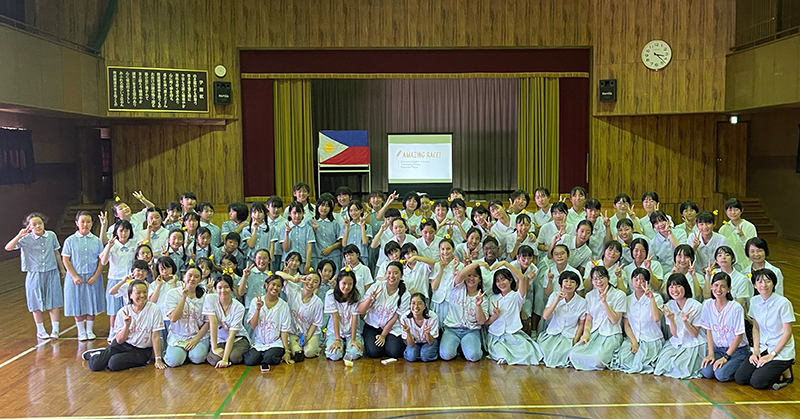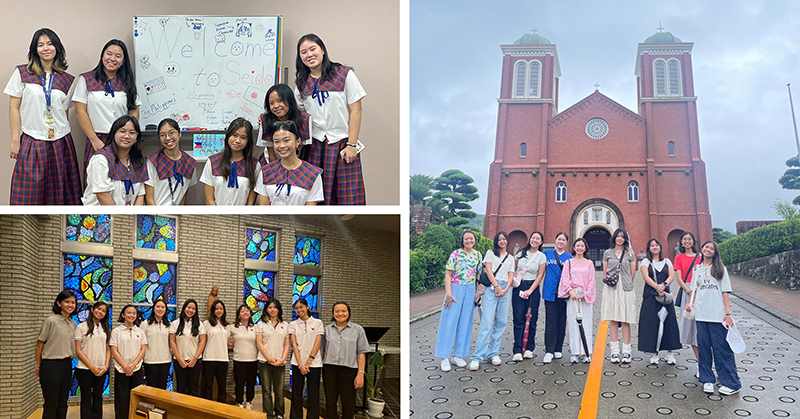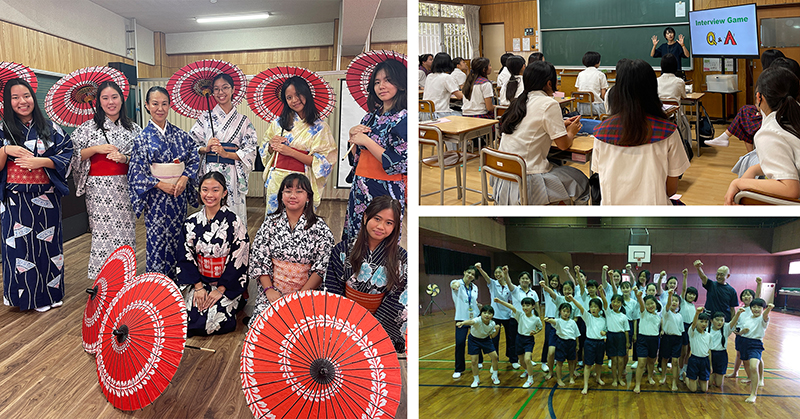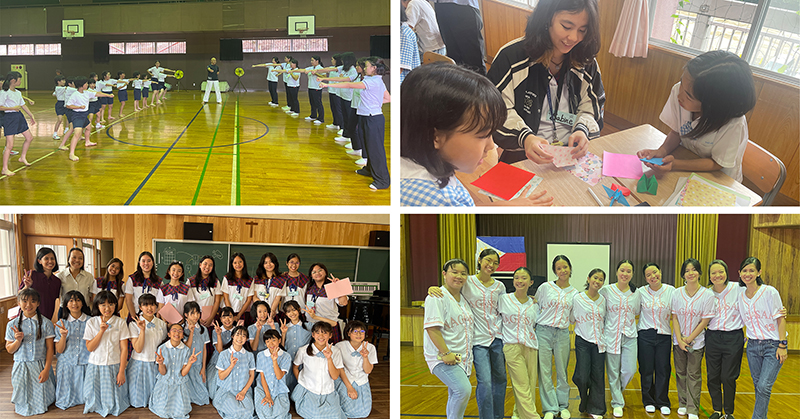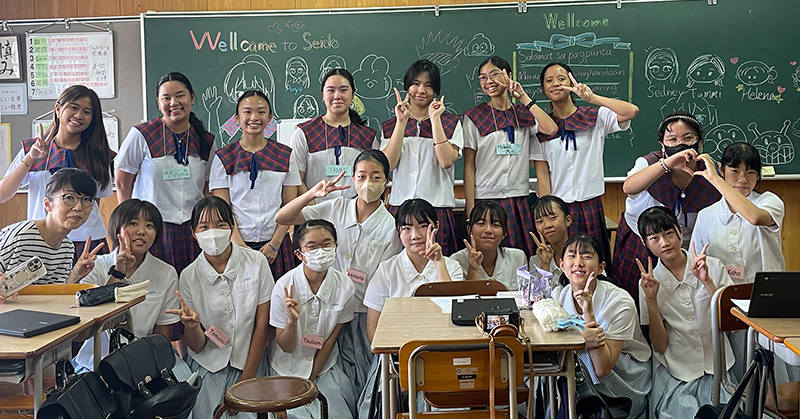Students also organized a cultural presentation for the students and teachers at Seido School. This program included teaching basic Filipino words and phrases, hosting Filipino games such as “Maria Goes to the Market,” and performing two dance numbers: “Sayaw sa Cuyo,” a traditional fiesta dance from Palawan, and “Salamin, Salamin” by the P-Pop girl group BINI.
The trip wouldn’t be complete without visiting Nagasaki’s historical and cultural sites, such as the 26 Martyrs Museum and Church, Urakami Cathedral, Oura Cathedral, Nyoko-do, Atomic Bomb Museum, Peace Park, and Suwa Shrine. Inspired by the unity, kindness, and generosity of the Japanese people, the students are eager to share their experiences with the rest of the school community.
The student exchange program was featured in the Seido School website as well as in the NHK News Web of a Japanese media company.
Learn more about the exchange program through the personal reflections of Helena Esguerra below:
A sentimental journey of kindness and peace is how I would describe my recent experience joining the Woodrose Exchange Program with Seido School in Nagasaki, Japan. When a group of Japanese exchange students visited Woodrose back when I was in Grade 7, I was so impressed at how they were able to leave their home and at a young age be part of a school activity outside their country. I told myself that I wanted to take part in an exchange program when my time comes, to experience traveling and to learn about a different culture.
I have always been fascinated by Japan’s history, in particular the atomic bombings. I read the story of Sadako (a little girl famous for creating a thousand paper cranes) and I was inspired to learn how to make paper cranes.
Yet when the time for applications to the exchange program came up for incoming seniors like me, I hesitated to sign up for a number of reasons which were mostly fed by irrational fears. With a lot of prayers and guidance from my parents and my mentor, considering what a rare opportunity this was and how it might never come by me again, I finally took the plunge and made the first step into fulfilling a childhood dream. All my uneasiness was changed into excitement when I found out that one of my best friends, Reese Javier, was also accepted along with my batchmates Isa Sumulong, Sabine Sarmiento, Tammi Araneta, Anya Aure, Sydney Figueroa, and Isabel San Pedro. What added to the excitement was the news that my mentor, Ms. Sabel Diaz, and Mrs. Malou Roque would be our teacher-companions for the entire trip.
Preparing for the exchange program was a tedious process and the one that occupied much of my time and energy was getting my DSWD certificate. I recall how tired and stressed I was just to make sure I had completed and grouped all the necessary documents together. Besides this, there were still some high points such as practicing for our cultural presentation and learning essential Japanese phrases. For our cultural presentation, my group prepared to perform two dances: “Sayaw sa Cuyo” (a traditional fiesta dance from Palawan) and “Salamin, Salamin” by the P-Pop girl group, BINI. Although we all came home after every practice day with tired feet, we persevered because we wanted to proudly showcase our lively culture to the Japanese students.
On June 18, we took a 3-hour flight from Manila to Fukuoka Airport, then made our way to the bus station where we boarded another 3-hour bus ride to Nagasaki. When we reached Showamachi Station, we were met by two teachers from Seido School. They brought us to their school where we were introduced to our host families. Reese Javier and I were assigned to the Haruyama and Idemoto families who were very welcoming and eager to meet us!
The next five days with our host family will forever be part of my core memories. I will never forget their hospitality, kindness, and patience (whenever there would be a gap in our communication). I will always remember how they told us to call them Nami-mama and O-mama, how we ran together from the garage to the front door under the pouring rain, our spontaneous adventures daily after school (the best one was going to Mt. Inasa and seeing almost everyone in the Woodrose group unexpectedly), and all the laughter and stories we shared over scrumptious meals.
After reflecting on that exhilarating trip, I came home bearing two important takeaways. Firstly, the unbreakable bond of Japanese Catholics with the Faith. Part of our itinerary was visiting the 26 Martyrs Museum, Nyoko-do, Urakami Cathedral, and Oura Cathedral. Through their exhibits, I discovered much of their history and how deeply rooted the Japanese (and foreign) Catholics were in the Faith amidst the persecution of Christians. Two important figures were St. Paul Miki, one of the 26 martyrs, and Dr. Takashi Nagai. Though they led different lives, they both exhibited a strong love for God and humble service to their families and communities. These realizations made me reflect on how I could apply these to my own life; and from here, I made strong resolutions to look up to these saints as inspiration for living a pious life. It was from them that I desired to love God more and get to know Him more than I know Him now.
Lastly, the magnifying effect of kindness in the lives of the Japanese is something that truly resonated with me. Being deeply immersed in Japanese lifestyle and culture while living with my host family, and later at Mikawa Seminar Center, I witnessed how their simple acts of kindness to one another contribute to a healthy family environment. It’s in the little things my host family did that made me feel loved and cared for. Even as I went around the city some folks who would meet my eyes would smile at me and even greet me sometimes! It made me feel acknowledged, and they did these things not just because I was a foreigner, but because they knew it was the respectful thing to do. As the incoming president of the school’s kindness organization, RAYS (Rise Above Yourself), I plan to incorporate this particular learning in upcoming projects this school year. I believe that educating my school community and fellow Filipino students on the significance of kindness and its importance in cultivating a life of peace and unity can truly make our school (and eventually Filipino society) thrive.

